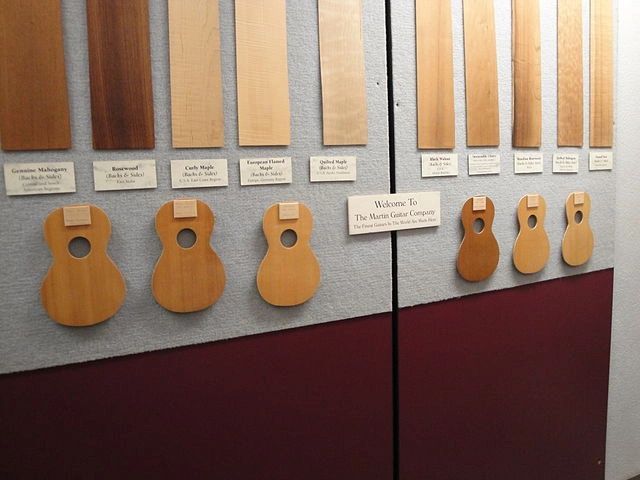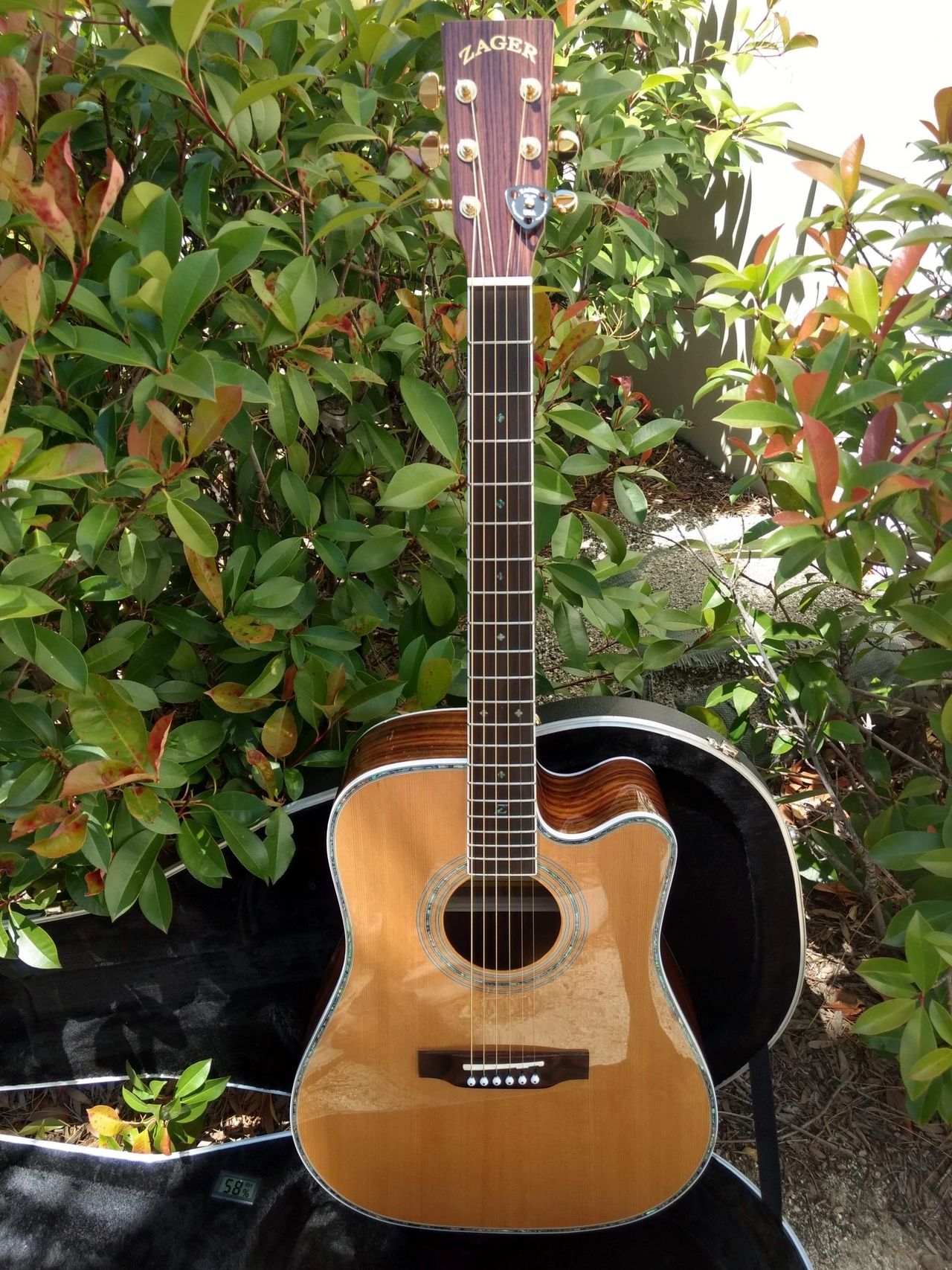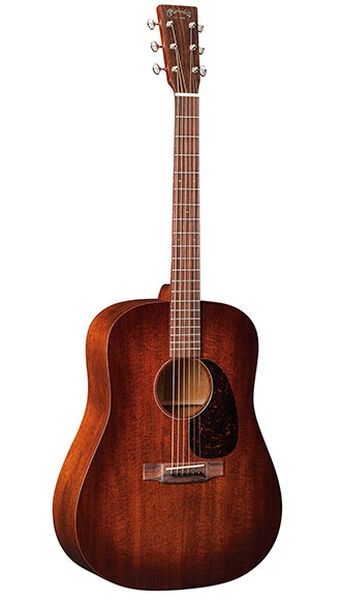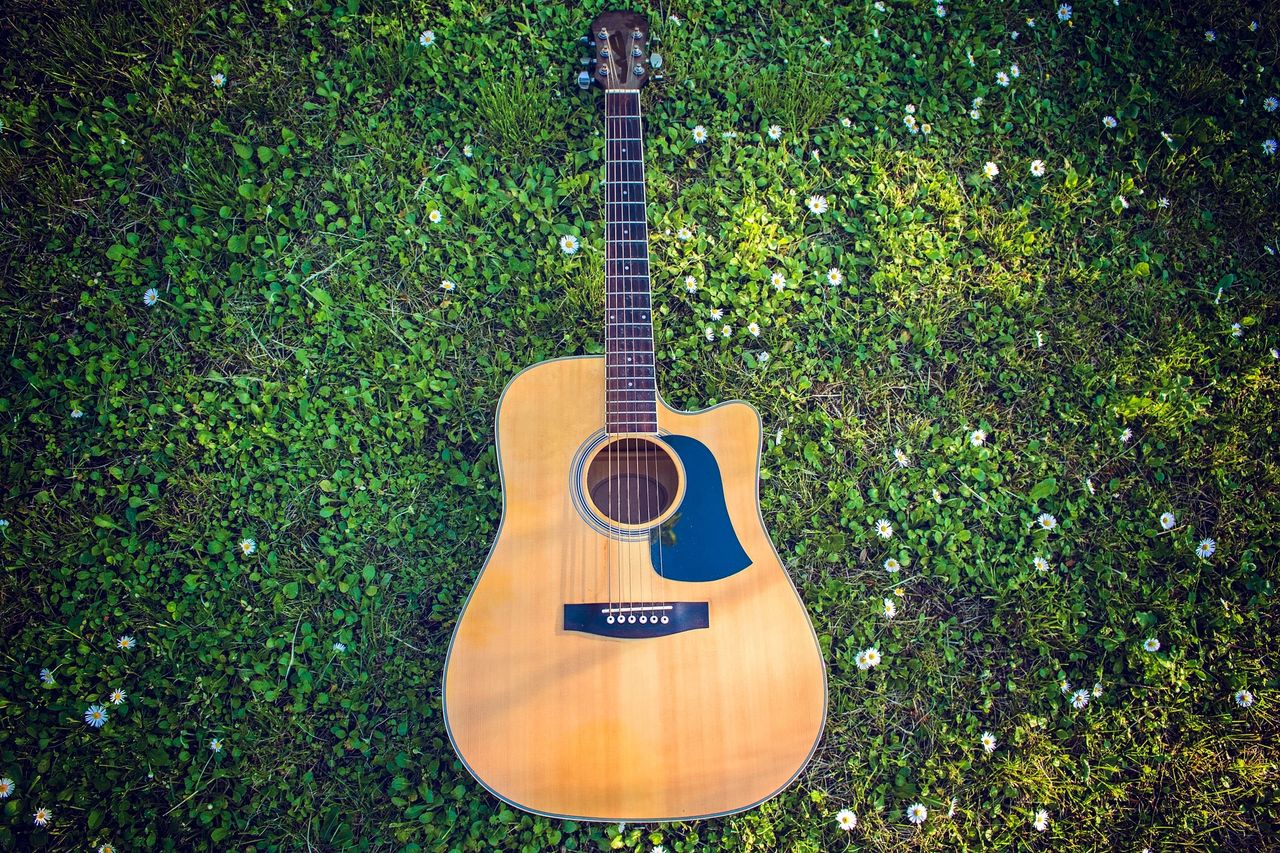Choosing the best acoustic guitar largely depends on your musical preferences, style, price, and comfort level. Unlike other instruments, an acoustic guitar feels like it’s alive when considering how resonant the wood sounds and how it feels when you fingerpick or strum your way through a song. It’s vital to find a guitar that aligns with your needs and feels like “home” while playing it.
Buying the best acoustic guitar is a big decision, but it doesn’t have to be so complicated. Here’s a breakdown of what to know about acoustic guitars and the best models to choose from.
What to Look for When Buying an Acoustic Guitar
There are several factors to consider when finding the right acoustic guitar, starting with the style and body you choose.
Body Style

The body style you choose for an acoustic guitar significantly impacts its sound and playability, starting with size. Some acoustic guitars are built larger to provide a more resonant sound from the tonewoods or accommodate players of a larger stature. But you can also find travel or parlor guitars that are usually more comfortable for players with smaller hands.
The shape of your acoustic guitar will also impact how it feels when you play and the sound it creates. Let’s take the classical dreadnought guitar as an example. Its wide, rounded body produces a full sound, and a smaller concert guitar with a narrow body will have a more balanced tone.
Some acoustic guitars also come with a cutaway in the body, which often makes them easier to play when hitting the upper frets. However, not all guitar players play higher on the neck or feel challenged by the lack of a cutaway.
Tonewoods
The best acoustic guitars are made with quality tonewoods or a mix of tonewoods and synthetics to produce a consistent and rich tone. The top of your guitar is constructed with “top wood,” commonly made from spruce, cedar, and mahogany. Spruce construction has a bright, crisp sound, and cedar tops usually produce a warmer, mellower tone. Mahogany top wood usually produces a midrange, focused sound.
The back and sides of an acoustic guitar will also impact its tone and are usually crafted from rosewood, mahogany, and maple. You may recognize rosewood for its rich, complex sound, while mahogany feels warmer and more balanced. Maple usually sounds bright and clear while you play.
The wood of your guitar neck can make a difference in how your guitar sounds and feels when you play. Like the rest of the guitar, mahogany is often picked for its warm tone, while maple sounds snappier.
Fingerboard and Bridge Wood
The fingerboard is the area of the guitar where you press down on the strings to produce the notes you want. Again, many brands choose rosewood for a warm and rich sound. However, ebony wood is also an option if you want to play something brighter and more articulate. For something clear and resonant, try a fingerboard or bridge made from maple wood.
Neck Profile

The neck profile of an acoustic guitar impacts how easy and comfortable it is to play. Guitars usually have a “C” or “V” shape, with the C-shaped neck regarded as the most comfortable for players with average or smaller hands. V-necks are well-suited for players with larger hands or anyone who wants a substantial grip.
Beyond the shape of the neck profile, its width also matters. A wider neck is usually more comfortable for fingerstyle playing with larger hands. Narrow necks are usually best suited for small hands. Some guitar brands have signature style necks, like Zager Guitars, that are handcrafted with a narrow style and strings set slightly closer together for a pillow-touch playing style that proves more comfortable.
Strings
It’s not always on the forefront of players’ minds what kind of strings an acoustic guitar should have, and although many are universal, they can also be uniquely different. The gauge or thickness of a guitar string will produce a specific sound. The thicker the string, the fuller and more resonant it sounds. The thinner the string, the easier and brighter they usually are to play, and the brighter the sound. Classical guitars usually have nylon strings.
However, most acoustic guitars will have the following:
- Bronze – bright and crisp sound
- Phosphor bronze – warm, rich tone
- Nickel strings – Less common, but sound brighter than phosphor bronze and warmer than bronze
Some guitar brands coat their strings to make them more comfortable or resonant to play. For example, Zager Guitars features EZ-Play pillow-touch coated strings for an ultra thin coating and buttery feel that leaves you with less finger squeak.
Electronics
Some acoustic guitars are ready to play right out of the box and don’t have any built-in electronics. Others include the ability to amp up your guitar, which is essential when playing out or gigging with friends.
An electro-acoustic guitar will include pickups and internal microphones. Piezo pickups are the most common, and you’ll usually find them mounted underneath the bridge or saddle of your guitar. As the name implies, the soundhole pickups are mounted inside the soundhole, and internal microphones are found inside the guitar.
To get a true sense of how the amp sounds, you’ll need to play the guitar through an amplifier to listen for distortion and feedback. Ideally, you want an acoustic guitar with electronics that produce a clear, balanced tone that sounds good, no matter how fast you play.
Best Acoustic Guitars

Once you have an idea of what to look for in your next acoustic guitar purchase, here are some of the best models to consider.
1) Zager ZAD80CE
The Zager ZAD80CE boasts a solid Sitka spruce top, solid rosewood back, and solid rosewood sides for a warm and balanced sound that guitar players covet. Bracing inside the guitar helps maximize good quality and volume that pair well with fingerstyle picking and strumming. All of Zager Guitars are known for their “playability-enhancing” modifications to guitars that make it easy for beginners and players with arthritis or hand injuries. The Zager ZAD80CE has lower action, a narrower nut width, and a modified neck shape that keeps your hand from getting tired, even while playing fast and accurately.
Buy the Zager ZAD80CE for $1,795.
2) Yamaha FG800
A classic-looking guitar at a reasonable price, the Yamaha FG800 features a dreadnought style and a solid spruce top. The price makes it a good pick for beginners, and it has a solid sound, but pro guitar players will notice the sound difference with sides made from nato wood. Its slim neck should feel comfortable to play with, and you can make easy adjustments with the help of a built-in automatic tuner.
You can pick up the Yamaha FG800 for $300 or less.
3) Epiphone Inspired By Gibson J-45
The J-45 Aged Vintage Sunburst Gloss takes a nod to the early days of rock and roll. It comes with solid wood construction and a C-neck profile that’s easy to hold while playing along the 20 medium jumbo frets. This guitar has an under-saddle pickup and preamp to power your next performance.
Buy the Epiphone Inspired By Gibson J-45 for $749.
4) Martin SC-13E
The Martin SC-13E comes with a patented neck design for easier access to even the highest frets for longer and louder playing. Its asymmetrical body allows for more gain before you start hitting feedback obstacles. Like the rest of the Martin line, this acoustic guitar still sounds great when unplugged.
You can start playing the Martin SC-13E for $1,599.
5) Fender CD-60S All-Mahogany
The Fender CD-60S All-Mahogany boasts a solid mahogany top for an organic sound. With a dreadnought style, it’s constructed with a warm, mellow tone, an all-mahogany body, mahogany back and sides, and a walnut fingerboard. It looks high-end but comes at a budget-friendly price that’s well-suited for beginners.
Pick up the Fender CD-60S All-Mahogany for $199.
6) Taylor 214ce Plus
Made from East Indian rosewood back and sides, the Taylor 214ce Plus is constructed with quality tonewoods and a layered rosewood back and sides and stunning Sitka spruce top. It has a versatile sound to accommodate a variety of musical settings and a broad tonal spectrum. Its Grand Auditorium shape and Venetian cutaway are well-suited for fingerpicking, flat-picking, or mediums strumming while producing that classic Taylor acoustic sound.
The Taylor 214ce Plus acoustic guitar is priced at $1,299.

7) Martin D-15M Burst
The Martin D-15M Burst is crafted from all-mahogany and has a dreadnought style to produce deep overtones and fill out those higher vocals on stage. Its satin-finished neck is comfortable to play with and has a low oval neck carved for an easy fit in your arms. It’s an elegant and simple acoustic guitar for a player who wants a great, high-quality sound without all the fuss of aesthetic flourishes and details.
Buy the Martin D-15M Burst for $1,499.
8) Gibson G-45
The Gibson G-45 is outfitted with a Sitka spruce top, walnut body, mahogany neck, and ebony fingerboard for superior sound. The selection of tonewoods leads to a more versatile and resonant sound. With a comfortable neck, this guitar sounds crisp and articulate and feels comfortable in your hands, whether you’re a beginner or a pro.
Start playing the Gibson G-45 for $1,199.
9) Takamine P3NY
The Takamine P3NY has a slotted headstock and pinless bridge to enhance sound and playability. It’s outfitted with a fast-playing mahogany neck and bold resonance from its parlor-style body for more comfortable playability. With an amplified tone from built-in electronics, its scalloped X-braced solid cedar top sounds rich and resonant.
Pick up the Takamine P3NY for $1,499.99.
10) Guild A-20 Marley
Inspired by Bob Marley’s at-home songwriting guitar, the Guild A-20 Marley commemorates the reggae legend. This Guild guitar is designed with songwriters in mind for its top-notch sound with a solid spruce top and mahogany back and sides for robust projection. A C-shaped mahogany neck and a smooth pau ferro fingerboard are built for playability and response for enhanced resonance.
Start playing the Guild A-20 Marley for $399.
Why Are Some Acoustic Guitars More Expensive than Others?
As you start your buying journey, you’ll notice that some acoustic guitars are wildly more expensive than others. But why? And more importantly, are more expensive guitars worth it? Here’s what you need to know about how guitar brands settle on pricing and whether or not it’s worth it to you.
Craftsmanship
The attention to detail and craftsmanship that go into making a guitar can significantly impact its average price. Higher-end guitars are often made by experienced luthiers who use traditional techniques to ensure the best possible sound and playability. Other guitars are mass-manufactured in factories, and although they can still be decent quality, they lack that handcrafted attention to detail.
Quality
Higher-end guitars usually feature premium woods that sound great when played, such as solid spruce, rosewood, or mahogany. Some guitar brands will introduce a higher-end model, then use a mix of tonewoods and synthetics to create a less expensive version. The quality may still hold up, but it depends on what type of music you want to play and how selective you are about how your acoustic guitar sounds.
Hardware also matters. Your tuning machines, bridge, and nut will impact the price. The higher the quality of the materials, the better it will likely sound while increasing its cost.
Brand Recognition
The guitar brand you choose significantly impacts the price of your guitar. Some brands come with a legendary track record for success and praise, and you’ll see it reflected in the price. The cost may be worth it to you, but you’ll probably find there’s always a comparable and less expensive version of the most premium models out there.
Retail Markup
Depending on the brand and the store you buy it from, you may see markups of 20% to 30% on any guitars you purchase. It makes sense. The brand, manufacturer, and store all need to make a profit, but those costs are passed onto the consumer. Retail prices are a part of the mainstream shopping experience, but there are other options to choose from.
For starters, you can buy a used or refurbished guitar directly from another guitar player. Or you can purchase from a company that sells direct to the consumer, like Zager Guitars. With a free, two-way shipping policy, you can try out one of their guitars and skip the inflated retail prices at the store.
Limited Production Runs
Some guitars are produced as limited edition models that are harder to find and stir demand. Their exclusivity drives up the price and could make them a collector’s item. However, a limited edition could be worth the investment if you plan to collect or resell your guitar.
Overall, expensive guitars do sound better and come with higher quality and standards for craftsmanship. There is a point where the return on your investment (ROI) starts to taper off. For example, some brands, like Fender are more expensive based on their name alone, even though you can find a similar model from other guitar companies. Paying the full retail price will also drive up your costs.
However, if you’re a hobbyist and enjoy tinkering with your guitar, you can go cheap on your purchase and still find something decent to play. You can always sell your first acoustic guitar and scale up to something of higher quality if you decide to get more ambitious with learning the craft and want the best sound possible.
Acoustic Guitar Winner
We’re fans of Zager Guitars for their reasonable price point, high-quality craftsmanship, and thoughtful touches. From their pillow-touch, carbon coated strings to their unique neck profiles, the brand is focused on comfort and playability without compromising sound. Zagers are easy to play and sound great while doing it.
A Brief History of Acoustic Guitars

Acoustic guitars were once in limited supply and demand, with few choices. The history of the instrument dates back to ancient times, but you can trace its more modern origins to the early 19th century. Greeks first used a guitar-like instrument, or the kithara, a type of lyre. Over time, the kithara led to an evolution of stringed instruments, including the lute and baroque guitar.
By the late 18th century, Spanish guitar maker Antonio de Torres Jurado had introduced a fan-bracing system on the guitar and revolutionized the design to include the fuller and richer sound that you hear today on classical guitars. The United States didn’t see a mainstream instrument in guitars until the mid-19th century, when the instrument became a staple for folk and country music. Some guitar makers started experimenting and chose steel strings instead of the traditional gut version, leading to our current steel-string acoustic guitar.
The 20th century introduced the classic dreadnought style with a larger body to produce a deer and a more resonant sound. It’s among the most popular acoustic guitars among country and folk musicians and spurred a revival during the 1950s and 1960s led by artists including Bob Dylan and Joan Baez.
The rise in popularity of the acoustic guitar also led to brands catering to aspiring musicians or sponsoring their tours and performances. Today, some guitar brands are synonymous with specific musicians. For example, Bob Dylan frequently played Gibson Guitars, and Johnny Cash gravitated towards Martin Guitars.
Next Steps
Finding the best acoustic guitar comes down to personal preference, whether comfort, brand recognition, or price are the most important things to you. However, the most important thing isn’t always deciding which instrument to buy but getting started at all and prioritizing the time to learn. Weigh the pros and cons of each aspect of buying a guitar to find the best choice for you. The best part is that there’s always another guitar out there waiting as your preferences and style evolve as a player.
